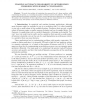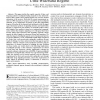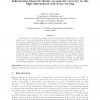107
Voted
TSP
2010
14 years 7 months ago
2010
Abstract--A cooperative approach to the sensing task of wireless cognitive radio (CR) networks is introduced based on a basis expansion model of the power spectral density (PSD) ma...
119
Voted
SIAMJO
2010
14 years 7 months ago
2010
We study the problem of minimizing the expected loss of a linear predictor while constraining its sparsity, i.e., bounding the number of features used by the predictor. While the r...
103
Voted
INTERSPEECH
2010
14 years 7 months ago
2010
Sparse Component Analysis is a relatively young technique that relies upon a representation of signal occupying only a small part of a larger space. Mixtures of sparse components ...
123
Voted
ICCV
2009
IEEE
14 years 10 months ago
2009
IEEE
This paper investigates a new learning formulation called dynamic group sparsity. It is a natural extension of the standard sparsity concept in compressive sensing, and is motivat...
96
Voted
PKDD
2010
Springer
14 years 10 months ago
2010
Springer
We consider the problem of numerical stability and model density growth when training a sparse linear model from massive data. We focus on scalable algorithms that optimize certain...
58
Voted
EMNLP
2010
14 years 10 months ago
2010
Part-of-speech (POS) tag distributions are known to exhibit sparsity -- a word is likely to take a single predominant tag in a corpus. Recent research has demonstrated that incorp...
116
click to vote
TIP
2010
14 years 11 months ago
2010
Abstract—This paper introduces a novel examplar-based inpainting algorithm through investigating the sparsity of natural image patches. Two novel concepts of sparsity at the patc...
106
Voted
CORR
2007
Springer
15 years 24 days ago
2007
Springer
— In contrast to the prevalent assumption of rich multipath in information theoretic analysis of wireless channels, physical channels exhibit sparse multipath, especially at larg...
91
Voted
CORR
2007
Springer
15 years 24 days ago
2007
Springer
—This paper studies the ergodic capacity of time- and frequency-selective multipath fading channels in the ultrawideband (UWB) regime when training signals are used for channel e...
107
Voted
CORR
2007
Springer
15 years 24 days ago
2007
Springer
The problem of recovering the sparsity pattern of a fixed but unknown vector β∗ ∈ Rp based on a set of n noisy observations arises in a variety of settings, including subset...



